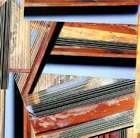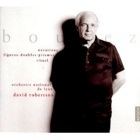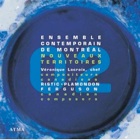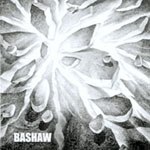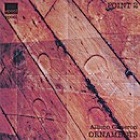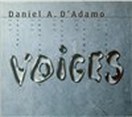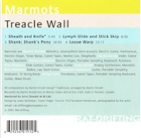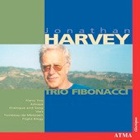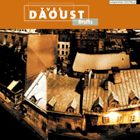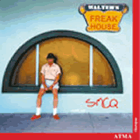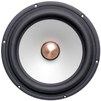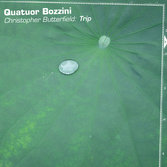
Christopher Butterfield - Trip: Quatour Bozzini
Collection QB CBQ 1719
For its twenty-third CD, Quatour Bozzini has produced a monograph recording with an almost-chronological retrospective of music by Christopher Butterfield. Spanning more than twenty years, it contains two pieces for solo strings, a sextet (with beach whistle), and two string quartets. Clinamen, (the Latin name Lucretius gave to the unpredictable swerve of atoms), for solo violin (1999), is made up of eighty cards, each containing a short musical phrase, combined according to the free will of the performer. Intentionally inchoate, the piece is foremost bound together by the honey tone of Clemens Merkel’s playing, and yet, there are whispers of its compositional technique, as though related materials were sketched, bent through historical filters from classical music to modern, and then splayed by means of William S. Burrough’s cutup technique.
Fall (2013), written for the full quartet, is the perfect vehicle for Bozzini’s signature non-vibrato playing. At times haunting and tense, their sound is also unadorned, unaffected and exquisite. Engaged in material processes of rotation and accumulation, the ensuing tone of the piece is plaintive and distantly evocative of Cage’s String Quartet in Four Parts. The namesake quartet Trip (meaning possibly all of excursion, to dance or run lightly, to stumble or fall, to release and raise an anchor, and to hallucinate) is an outlandish journey from a short Scorrevole movement augmented by a random talk radio broadcast, through a moto perpetuo, to a swaying, recapitulatory Scherzo. The last movement, marked Molto Adagio, is longer than the preceding movements combined, and sounds not simply slow, but like a time-stretched recording, where the smallest, usually ordinary timbral deviation is magnified and burnished, while notes, lines, and harmonies are expanded into tranquillizing beauty.
Collection QB CBQ 1719
For its twenty-third CD, Quatour Bozzini has produced a monograph recording with an almost-chronological retrospective of music by Christopher Butterfield. Spanning more than twenty years, it contains two pieces for solo strings, a sextet (with beach whistle), and two string quartets. Clinamen, (the Latin name Lucretius gave to the unpredictable swerve of atoms), for solo violin (1999), is made up of eighty cards, each containing a short musical phrase, combined according to the free will of the performer. Intentionally inchoate, the piece is foremost bound together by the honey tone of Clemens Merkel’s playing, and yet, there are whispers of its compositional technique, as though related materials were sketched, bent through historical filters from classical music to modern, and then splayed by means of William S. Burrough’s cutup technique.
Fall (2013), written for the full quartet, is the perfect vehicle for Bozzini’s signature non-vibrato playing. At times haunting and tense, their sound is also unadorned, unaffected and exquisite. Engaged in material processes of rotation and accumulation, the ensuing tone of the piece is plaintive and distantly evocative of Cage’s String Quartet in Four Parts. The namesake quartet Trip (meaning possibly all of excursion, to dance or run lightly, to stumble or fall, to release and raise an anchor, and to hallucinate) is an outlandish journey from a short Scorrevole movement augmented by a random talk radio broadcast, through a moto perpetuo, to a swaying, recapitulatory Scherzo. The last movement, marked Molto Adagio, is longer than the preceding movements combined, and sounds not simply slow, but like a time-stretched recording, where the smallest, usually ordinary timbral deviation is magnified and burnished, while notes, lines, and harmonies are expanded into tranquillizing beauty.
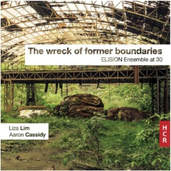
The Wreck of Former Boundaries: Elision Ensemble at 30
Works by Aaron Cassidy and Liza Lim
HRC13CD
Celebrating thirty years of engagement with complex and challenging aesthetics, Australia’s Elision ensemble have released The Wreck of Former Boundaries, a live recording featuring their 2016 Huddersfield Contemporary Music Festival performances of the eponymous work by Aaron Cassidy, and How Forests Think, by Liza Lim.
In his bountiful thirty-three minute work, Cassidy writes remarkable musical situations for Elision’s consummately nimble cast. His “diagonal” consideration of instrumental colour facilitates their concentration on not just the notes, but continuous timbral flux expressed through idiomatically applied glissandi, pressure variance, embouchure tension, and dynamic changes. In the liner notes, Cassidy describes the work as a double trumpet concerto, while elsewhere he calls it six standalone pieces that can be performed independently. It projects, however, as a fluid stream of restless, stratified solos and duos with infrequent, disjunct episodic interjections from the ensemble. Crispy, familiar electronics pursue contours of similar profile to the instrumental writing, prodigiously applied in the potent latter third of the work.
Liza Lim’s How Forests Think reflects on anthropologist Eduardo Kohn’s nuanced idea of forest ecologies as intersecting communities and social networks (human and non-human). Musical identities share succulent attributes, supporting, absorbing, and transferring them across the Chinese sheng and ensemble parts. Whereas Cassidy revels in anxiously winding materials through self-referential guides, Lim’s understory focusses on a different manner of complexity, nourished by outward-pointing substrata that creep and trail across the work. The result is poly-referential and broad, in vocabulary and scope, with deftly probed textures propagating a vital, bifurcating soundscape.
Works by Aaron Cassidy and Liza Lim
HRC13CD
Celebrating thirty years of engagement with complex and challenging aesthetics, Australia’s Elision ensemble have released The Wreck of Former Boundaries, a live recording featuring their 2016 Huddersfield Contemporary Music Festival performances of the eponymous work by Aaron Cassidy, and How Forests Think, by Liza Lim.
In his bountiful thirty-three minute work, Cassidy writes remarkable musical situations for Elision’s consummately nimble cast. His “diagonal” consideration of instrumental colour facilitates their concentration on not just the notes, but continuous timbral flux expressed through idiomatically applied glissandi, pressure variance, embouchure tension, and dynamic changes. In the liner notes, Cassidy describes the work as a double trumpet concerto, while elsewhere he calls it six standalone pieces that can be performed independently. It projects, however, as a fluid stream of restless, stratified solos and duos with infrequent, disjunct episodic interjections from the ensemble. Crispy, familiar electronics pursue contours of similar profile to the instrumental writing, prodigiously applied in the potent latter third of the work.
Liza Lim’s How Forests Think reflects on anthropologist Eduardo Kohn’s nuanced idea of forest ecologies as intersecting communities and social networks (human and non-human). Musical identities share succulent attributes, supporting, absorbing, and transferring them across the Chinese sheng and ensemble parts. Whereas Cassidy revels in anxiously winding materials through self-referential guides, Lim’s understory focusses on a different manner of complexity, nourished by outward-pointing substrata that creep and trail across the work. The result is poly-referential and broad, in vocabulary and scope, with deftly probed textures propagating a vital, bifurcating soundscape.
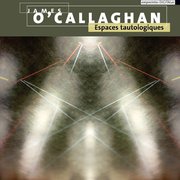
JAMES O'CALLAGHAN
empreintes DITIALes IMED 16140 2016
cover image by Mark Mushet
On his recent electroacoustic CD Espaces Tautologiques, composer James O’Callaghan takes us down the rabbit hole into a visceral, endogenous acousmatic wonderland. Although tautologies can be defined as “needless” repetitions, for O’Callaghan, they instead may be an ironic unifying premise for his vagabond auditory adventures, or append extra significance to compositional procedures such as varied repetition, imitation, and augmentation. The first three pieces (Objects-Interiors, Bodies-Soundings, and Empties-Impetus) form a triptych that “imagine(s) the sounding bodies of instruments as resonant spaces.” They contain crisp, natural, and remodeled recordings of passages through remote instrumental spaces, and at times it feels as though the listener is situated inside the instrument. From the rim to the spine of a piano (Objects-Interiors), an acoustic guitar and toy piano (Bodies-Soundings), or the surfaces and recesses of instruments in a string quartet (Empties-Impetus), each piece celebrates the percussions and resonances of a similar, colourful palette of instrumental and digital treatments. O’Callaghan demonstrates fluency with standard techniques of electroacoustic music, but it’s the impetus of the philosophical aspects that takes the pieces to their most compelling territories. The last piece Isomorphic, is a particularly captivating jaunt through protractions of carefully ordered squealing, chattering textures. While the work shifts from one archetype to another, it’s coherently driven by consecutive, playful morphological relationships that extend from one sound to the next, despite differences of sound source and context. By virtue of the gesture, contour, pitch, and timbral coherence of his materials, O’Callaghan proposes contrasting ways to consider the ornithological chirps, industrial doors, and ambient environments. They can be heard as a perpetual flow, in which all sounds are related as one, or as a duality in which the listener simultaneously compares the ongoing profile similarities of the sounds with their wildly differing origins.
empreintes DITIALes IMED 16140 2016
cover image by Mark Mushet
On his recent electroacoustic CD Espaces Tautologiques, composer James O’Callaghan takes us down the rabbit hole into a visceral, endogenous acousmatic wonderland. Although tautologies can be defined as “needless” repetitions, for O’Callaghan, they instead may be an ironic unifying premise for his vagabond auditory adventures, or append extra significance to compositional procedures such as varied repetition, imitation, and augmentation. The first three pieces (Objects-Interiors, Bodies-Soundings, and Empties-Impetus) form a triptych that “imagine(s) the sounding bodies of instruments as resonant spaces.” They contain crisp, natural, and remodeled recordings of passages through remote instrumental spaces, and at times it feels as though the listener is situated inside the instrument. From the rim to the spine of a piano (Objects-Interiors), an acoustic guitar and toy piano (Bodies-Soundings), or the surfaces and recesses of instruments in a string quartet (Empties-Impetus), each piece celebrates the percussions and resonances of a similar, colourful palette of instrumental and digital treatments. O’Callaghan demonstrates fluency with standard techniques of electroacoustic music, but it’s the impetus of the philosophical aspects that takes the pieces to their most compelling territories. The last piece Isomorphic, is a particularly captivating jaunt through protractions of carefully ordered squealing, chattering textures. While the work shifts from one archetype to another, it’s coherently driven by consecutive, playful morphological relationships that extend from one sound to the next, despite differences of sound source and context. By virtue of the gesture, contour, pitch, and timbral coherence of his materials, O’Callaghan proposes contrasting ways to consider the ornithological chirps, industrial doors, and ambient environments. They can be heard as a perpetual flow, in which all sounds are related as one, or as a duality in which the listener simultaneously compares the ongoing profile similarities of the sounds with their wildly differing origins.
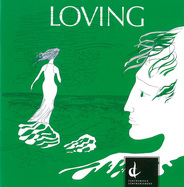
R. MURRAY SCHAFER – LOVING/TOI
Centrediscs / Centredisques SKU: CD-CMCCD 22516
R. Murray Schafer’s 70-minute bilingual “synaesthetic” chamber work Loving (Toi) was written between 1963 and 1965 (the same year he wrote the pivotal book The Composer in the Classroom) , and was first performed on the CBC Television program L’Heure du Concert in 1966. A few months later it was rebroadcast on the CBC English network. Over thirteen years, L’Heure du Concert (produced by Pierre Mercure) brought a spectacular one hundred thirty three operas and one hundred thirty three ballets to CBC national television audiences. Mercure’s production of Loving (Toi) was his last, leaving several elements unfinished at the time of his sudden death at age thirty-nine. Fortunately, the Canadian Music Centre’s Centrediscs label recently reissued the excellent 1978 New Music Concerts recording of the first complete production that was originally released on the Melbourne Records label. It was conducted by Robert Aitken, and features strong performances by the entire group, including Mary Lou Fallis, Susan Gudgeon, members of the Purcell String Quartet, and Nexus, among others.
Loving (Toi) is Schafer’s first work for the stage (the 1978 NMC performance was semi-staged), predating the Patria Series, his String Quartets, and other works he is most known for. Clues that point to Schafer’s subsequent eclectic blending of multicultural mythological characters are abundant here, with Ishtar, the Mesopotamian goddess of fertility, love, war, and sex, cohabiting the work with the Greek god of love, Eros, in what Schafer calls a “confrontation between the male and female psyches.” Interspersed are the qualities and attitudes of Modesty, Vanity, The Poet, The Man, and The Woman, each given supporting colouration within the ensemble (Modesty as strings + accordion, Vanity as plucked instruments, Ishtar with percussion, and Eros using bells).
Schafer’s writing is broadly expressive, free-flowing synthesis of the avant-garde mannerisms of the epoch, warmly recorded spoken text, simple yet effective electroacoustic episodes, florid harp writing, and long vocal lines that sometimes foreshadow the neo-Romanticism that dominates his later work. While Schafer describes the work as ambiguous and exploring the depths of the unconscious, his consideration of human sexuality now seems dated in its binary focus on masculine and feminine. Fifty years later, however, the piece retains the sense of sonic inventiveness and integrated plurality that is synonymous with his best work.
Centrediscs / Centredisques SKU: CD-CMCCD 22516
R. Murray Schafer’s 70-minute bilingual “synaesthetic” chamber work Loving (Toi) was written between 1963 and 1965 (the same year he wrote the pivotal book The Composer in the Classroom) , and was first performed on the CBC Television program L’Heure du Concert in 1966. A few months later it was rebroadcast on the CBC English network. Over thirteen years, L’Heure du Concert (produced by Pierre Mercure) brought a spectacular one hundred thirty three operas and one hundred thirty three ballets to CBC national television audiences. Mercure’s production of Loving (Toi) was his last, leaving several elements unfinished at the time of his sudden death at age thirty-nine. Fortunately, the Canadian Music Centre’s Centrediscs label recently reissued the excellent 1978 New Music Concerts recording of the first complete production that was originally released on the Melbourne Records label. It was conducted by Robert Aitken, and features strong performances by the entire group, including Mary Lou Fallis, Susan Gudgeon, members of the Purcell String Quartet, and Nexus, among others.
Loving (Toi) is Schafer’s first work for the stage (the 1978 NMC performance was semi-staged), predating the Patria Series, his String Quartets, and other works he is most known for. Clues that point to Schafer’s subsequent eclectic blending of multicultural mythological characters are abundant here, with Ishtar, the Mesopotamian goddess of fertility, love, war, and sex, cohabiting the work with the Greek god of love, Eros, in what Schafer calls a “confrontation between the male and female psyches.” Interspersed are the qualities and attitudes of Modesty, Vanity, The Poet, The Man, and The Woman, each given supporting colouration within the ensemble (Modesty as strings + accordion, Vanity as plucked instruments, Ishtar with percussion, and Eros using bells).
Schafer’s writing is broadly expressive, free-flowing synthesis of the avant-garde mannerisms of the epoch, warmly recorded spoken text, simple yet effective electroacoustic episodes, florid harp writing, and long vocal lines that sometimes foreshadow the neo-Romanticism that dominates his later work. While Schafer describes the work as ambiguous and exploring the depths of the unconscious, his consideration of human sexuality now seems dated in its binary focus on masculine and feminine. Fifty years later, however, the piece retains the sense of sonic inventiveness and integrated plurality that is synonymous with his best work.
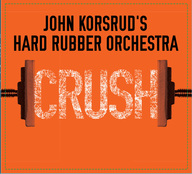
JOHN KORSRUD'S HARD RUBBBER ORCHESTRA – CRUSH
From note one, it’s clear that composer and bandleader John Korsud studied at the Burning Man school of jazz, forging his wide-ranging musical inspirations into a bubbling hot electric kool-aid. Crush is all about oppositions – between big band and chamber music instrumentations, as a mashup of musical genres, as competing strands within individual textures, and among the pieces, interpolating between the rabid (Crush, Lowest Tide, Slice, Wise Up) and the pensive (Peace for Ross, Mist 1 & 2). While the longer, heavier works symbolize a hydraulic press squeezing divergent energies out the seams, their shorter counterparts are the compacted, focussed units at the end of the process.
On first hearing some of the pieces may sound discombobulated, but further listening reveals that even the most frenetic surfaces are unified with careful constraint. In Crush, surrounding the flailing wildness of drummer Dave Robbins, percussionist Jack Duncan, and trumpet soloist Brad Turner, Korsrud displays near-tantric restraint with a slow, sustained low-register chorale, generating the tension that defines the piece. For Lowest Tide, among visceral clouds of fast and wirey ascending figures reminiscent of mid-period Ligeti, a Phil Dwyer solo scorches the Earth,Wind, & Fire-inspired groove, punctuated with metallic horn shots that turn into a buzzing sax section pulp. In Come to the Dark Side, a serpentine trumpet lead (played by Korsrud) is pitted against a consistently pneumatic, stuttering accompaniment loosely recalling John Adams’ Short Ride in a Fast Machine. Industrial-strength Mahavishnu Orchestra-styled ostinati churn their repetitions alongside gutteral baritone saxophone exhortations and Ron Samworth’s warped guitar playing in the final piece, Wise Up. If it seems like an implausible assemblage of ideas and sources, Korsrud and crew’s deft handling will flatten any doubt like a Jumping Jack Tamper on the sands of the playa.
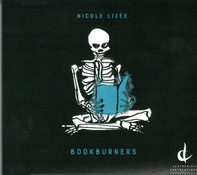
NICOLE LIZÉE – BOOKBURNERS (2 CDs)
Centrediscs / Centredisques SKU: CD-CMCCD 20514
In 2013, Canada’s government commited what scientists now call libricide, closing seven Department of Fisheries and Oceans libraries. Ostensibly, it was to save by digitizing materials, but that hasn’t happened. Little attempt was made to preserve the materials, and precious collections were lost to landfill. It was 21st century bookburning, but without the symbolic theatre.
Milton wrote that anyone who kills a man kills “a reasonable creature, God’s image; but he who destroys a good book kills reason itself.” The striking cover image of Nicole Lizée’s Bookburners CD/DVD (by Todd Stewart) may assert a similar interpretation. Depicting a skeleton holding a smouldering book, the figure may have sought to burn it, but instead self-immolated, consigning her/himself to eternal damnation, rather than squelching the ideas on the pages. Conversely, a dug-up, laughing skeleton having a good read fits in with the rough-hewn and somewhat nostalgic approach to technology and media that permeates the aesthetic of the five works in this collection.
The music and images tease us into dissecting the materials, reference points, and tools; a rich exercise with antennae outside European contemporary music and into pop cultural icons that are the shared knowledge of Lizée’s generation. Prog-rock chord progressions, American minimalist repetitions, post-digital glitch techniques, dj sound gear, and uncommon instrumentations are all there, crashing into one another, but listening exclusively that way becomes so fragmented that it prevents the pleasures of listening to the global textures. When identification of materials becomes second to hearing their blended interaction, the music opens up a bright tableau of complex rhythms and timbres, despite the darker undertones of the titles and subject matter.
On the CD, White Label Experiment, for percussion quartet, and electronics is a joyously warped mashup of John Cage and rave culture, with the turntable as the common denominator. Typewriters peck away, combined with stylus/needle drops, noise timbres, and omnichord, while metallic percussion takes you higher, in register and experience. Ouijist continues the attraction to sound hacking and an expansive, low-tech electronic palette built on the bent and the broken. On Son of the Man with the Golden Arms, Ben Reimer’s playing stands out with a crisp tone and light touch, relishing in the complexity of notated beats, which are at times reminiscent of Bill Bruford on the Yes Fragile album.
For the DVD, Lizée brings film into the mix. Hitchcock Études (for piano and “glitch”) works with the Lissajou-inspired credits from Psycho, excerpts from The Birds, and other middle-period Hitchcock films, looping them and jarring perception of the familiar into the strange and sometimes menacing. Paradoxically, the glitches are a byproduct of digital sound techniques, whereas the film sources she’s working with originate from the silver (analog) screen, meaning the glitch element is obtained by imposing new tech on old media. Bookburners is staged footage of turntablist DJ P-Love and cellist Stéphane Tétreault performing in a freight elevator/loading dock. Like the other pieces in this set, it’s a bit longer than the material suggests, yet achieves its goals more tamely. Without exception, these are excellent performances, artfully combined to express a fresh remix of North American musical mannerisms.
|
FRANCIS DHOMONT - Jalons
MONIQUE JEAN - L'adieu au s.o.s. EMPREINTES DIGITALES IMED 0365 IMED 0366 Anyone interested in electroacoustic and acousmatic music in Canada is already familiar with the EMPREINTES DIGITALES label and its catalogue of excellent artists and CD's. Jalons and L'adieu au s.o.s. are no exception. Jalons (meaning "milestones") is a collection of more obscure, less-performed works from Francis Dhomont's output between 1985 and 2001. A master of the acousmatic field he sowed and cultivated, Dhomont is also a sensitive recycler, recontextualizing and reworking the sound materials he carefully kneads. Some sources tire (the water sounds, the requisite footsteps, etc), while others are sparkle (the strings in Un autre printemps, and the guitar-based timbres of En cuerdas). These are sounds we know, materials we hear or confront every day in the natural world, here explored in great depth. From John Cage we learned to the extreme that every sound can be music, and from Dhomont we learn that every sound is a doorway to elsewhere, an ambiguous and mysterious portal. Experts will recognize the softwares and processes employed on the sounds - the trademarks, icons, and (at worst) clichés of the style - all the while remaining appreciative of the special care taken by the artist, and the attentiveness of his compositional ear. In a related vein, composer Monique Jean's L'adieu au s.o.s. (A farewell to S.O.S) explores a similar technical world, and a contrasting expressive voice. The difference between the two composers is that while both are capably occupied with frenetic and colourful textures, Jean is more likely than Dhomont to extend further into quiet, into a concentrated, multi-faceted stasis. Francis Dhomont's materials tend to be clipped in a quick, bright inhalation at the end of a phrase, while Jean allows her materials to settle, to breathe a touch longer. In the accompanying liner notes, Jean herself outlines aspects of this difference, writing that in Danse de l'enfant esseulée, the form "develops around the idea of the stoppage of time, or more precisely, its suspension... that of a momentary pause of sound, as much filled with tension as are points of suspension, inconclusive." While her music explores similar sonic terrain as other acousmatic composers, Jean's unhurried approach through her chosen soundscape and greater than usual comfort level with softer dynamic levels are an integral part of her individual voice. While her colleagues may have equal or superior technical skills in the electroacoustic music studio, her attention to the subtleties separates her work from the crowd. ORCHESTRE NATIONAL DE LYON/ROBERTSON
BOULEZ ORCHESTRE NATIONAL DE MONTPELLIER/ROPHE DUSAPIN CONCERTOS NAIVE/MONTAINGE MO782163, MO782153 On this recent recording, conductor David Robertson demonstrates why I hoped he would have received more serious consideration for a North American conducting post… a.k.a. the TSO. From his extended tenure as leader of one of the world’s best new music chamber orchestras (the Ensemble InterContemporain), and conducting traditional symphony orchestras worldwide, his knowledge is broad and current. As a former dancer, his skill and energy on the podium is clearly evident, as is some of the influence of this CD’s featured composer, Pierre Boulez. With near-impeccable intonation, Robertson leads the Orchestre National de Lyon through Boulez’s Rituel in memoriam Maderna (1974-75), five selections from Notations (1945, revised and orchestrated1980-98), and Figures-Doubles-Prismes (1963-68). Rituel, for orchestra in 8 groups is actually individualized chamber music, 25 minutes of relentless, serialized unpulsed percussion ostinati hyphenating a smoothly orchestrated, seemingly isorythmic melody. Reminiscent of Berio’s surface lines, they shift between flourish, sustain, flourish, sustain, and filigree. The more diverse Notations (the orchestral proliferation of an earlier piano piece) maintains the linear gestural foundation, with less restraint. Like Rituel, Figures… works with spatial distribution of orchestral instruments, displacing them into sub-groups underscoring structural principles of the work. Between the melodic motifs and infrequent time-point rhythms, Figures is in part the synthesis of the preceding two works. While Boulez’s CD confirms his clear aesthetic perspective and serves to further document his work, Pascal Dusapin’s CD of 3 concerti (one each for trombone, flute, and cello) partially thwarts some compositional concerns gathered from listening to his previous compositions. He’s extremely prolific, oft-performed, and obviously skilled, yet his music has seemed hurriedly written, or - more generously - automatic. At the same time, it’s often orchestrationally over-coifed, with attention to surface detail perhaps better spent on structural considerations. It’s colourful, clearly and confidently pitch-oriented, yet frequently subject to peculiar, oddly or awkwardly placed musical gestures. While these qualities may be the residual style effects from his teacher-consultants Xenakis and Donatoni, others have become elements of his gradually distinguishing personal voice. Watt (1994), for trombone and orchestra, is wonderfully performed by Canadian virtuoso Alain Trudel, and remains Dusapin’s best piece to date. Inspired by the Beckett novel of the same name, Watt is colourful and fluid, yet unpredictable, containing sub-sections of significant beauty, particularly the duet with piccolo. The other two works (Galim and Celo) also succeed, almost well enough to make one forget the inflated grandeur of the liner notes. Ensemble Contemporain de Montréal
NOUVEAUX TERRITOIRES 2 ATMA classique ACD22208 With the second disk in their Nouveaux Territoires series, the Ensemble Contemporain de Montréal solidify their place as a top-tier new music group. Led by conductor Véronique Lacroix, ECM delivers dynamic, spirited performances of music by Quebecers Sean Ferguson, Yannick Plamondon, and André Ristic. Each piece originated as part of ECM's multimedia event Unions Libres - involving dance, film, and text, respectively. While in many cases, the autonomous presentation of multimedia components reveals their shortcomings, Nouveaux Territoires confirms the merits of each as a concert piece. While intellectually Ferguson's Apocryphal Graffiti exists within the framework defined in the title, providing cleverly veiled, measured references and borrowings bent like the letters of a wall-painter's 'tag', it does so with subtlety, and not the 'phat' rawness and colour implied by his graffiti inspiration. Plamondon's Post is a "poetical study on the notion of entropy", concerned with artist Robert Smithson's relations between geology and the mind - mental rivers, cliffs of thought, erosion. Plamondon traverses his conceptual terrain with layered references, in superposed, relatively strict, jazz-ish rhythmic strata - progressive, but distinctly beat-oriented. Ristic's Catalogue des bombes occidentales employs a broad, heterogeneous approach to the ensemble, with interjections from the enchanting mezzo-soprano Marie-Annick Béliveau. While idiosyncratically mapping out and treating lists of musical objects "in the manner of large department stores", Ristic confidently balances his political, emotional, and musical concerns in a glowingly diverse (yet unified), special, sometimes humorous composition. Like Ferguson and Plamondon's pieces, Catalogue is performed with great commitment, accuracy, and energy from the ECM. MARC COUROUX AMERICAN DREAMING Xuotavip Records Since emerging from his Montreal practice lair some years back, Marc Couroux has been a confounding and necessary presence in Canadian new music. While remaining sought-after as a performer of some of the most intricate new piano music written, his restlessness and perpetual redefinition have heightened initial comparison to a young Glenn Gould. Each new work he tackles spawns numerous writings, discussions, and analyses, in which he seeks the core of the music and each layer to it. In this dedicated process of research and expression, new readings and studies take him mining elsewhere, into visual arts, film, cultural anthropology, and increasingly toward improvisation, where with his brilliant technique he can explore the cracks, fissures, and unpredictabilities of human experience. American Dreaming is a live recording of Couroux improvising after the study of filmmaker John Cassavetes. Herein, Couroux demonstrates his fascination with "areas in a seeming halfway-point between complete development and total underdevelopment· halfway states." To borrow Raymond Carney's description of Cassavates work and re-apply it to Couroux, he "offers us concatenated knowing in place of consolidating knowing. Rather than rushing to a portable meaning, the viewer (listener) is forced to live through a changing course of events. It lives in endless, energetic substitutions of one interest and focus for another, in continuous shifts of tone, in fluxional slides of relationship". American Dreaming is a fantastically unkempt truckload of ideas careening down a sometimes-frustrating thoroughfare, all revealed through Couroux's inimitable keyboard "touch". Despite his artistic preference of the process of becoming over the final result, I'm grateful that he chose to document this July 4th night and make it available on CD. |
HOWARD BASHAW
BASHAW, various works (2 CDs) Arktos Recordings 20039/40 Although the 9 works on this recording span 15 years of Bashaw's compositional output, there is a clarity of technique and idea which binds the music, developing chronologically through the torrential Hosu, for solo piano, to 1998's Music for Trombone and Piano. Often involving short, fragmentary bursts of instrumental colour, the music shifts between florid, torrential passages, sparse, elegant gestures recollecting Japanese Sumi-e painting (in which an economy of brush-strokes are used to communicate the essence of the subject), and mechanical, tense textures in which different tempo streams move simultaneously. Even with the fingerprints of Ligeti and Carter on his approach to rhythm and time, the Bashaw maintains a solidarity and unexpected introversion throughout, including the sometimes brutally physical piano writing. Seven spheres begins with a sequence of slow elegiac mensuration canons, each successive movement building on the basic multi-pulse premise, and culminating in the compressed fourth (central) section before deconstructing the music with the pointillist, scalar and celestial spheres that complete the structure. In Hosu, the cornerstone of his repertoire, Bashaw draws storms of swirling colour from the piano to create a breathing, poetic soundscape evocative of Liszt-ian mountains, and Debussy-an lakes. In Music for Organ and Piano, the characteristic piano writing of Hosu merges with some of the mechanistic preoccupations of Seven spheres, to create an engagingly peculiar, multi-dimensional piece with "live-electronics" associations. In the elegantly placid Eolian Braid (1995) the composer grapples with the question "What is this spell that wind chimes cast so effortlessly on the ear?" answering with a flowing complex of intertwined rhythmic strands of great beauty. 5 other works, including Music for Trombone and Piano, Timepieces, Preludes, Music for Tuba and Piano, and New Rage for Now Age complete this excellent portrait of Howard Bashaw's music. BRADSHAW PACK Alogos (SPP 201)
ALLISON CAMERON Ornaments (SPP 202) Uxbridge, Ontario-based SPOOL is a recent independent label aiming to represent a broad spectrum of experimental musicians. With the goal of developing a catalogue of works chosen for musical merit rather than commercial considerations SPOOL has focussed attention on three series of recordings. The LINE series of 11 CDs concentrates on improvisors such as percussionist Dylan van der Schyff, cellist Peggy Lee, guitarist Henry Kaiser, and clarinetist Francois Houle. The FIELD series of 2 disks documents artists "pushing back the boundaries of what is considered music", with an overlapping lineup of improvisors including other prominent West Coast musicians, and more. The POINT series represents new music composers, the first by Bradshaw Pack, the second by composer and Arraymusic artistic director Allison Cameron. Pack's CD, entitled ALOGOS (meaning absurd, or contrary to reason), consists of 5 pieces, four of which are interpolated between movements of the first piece. Prompt I is a tentative, delicate opening, shimmering with glassy extended techniques from the cello and processed guitar. Arioso Distante is an evocative deconstruction of period music. Through paraphrased fragmentation, Pack assembles a puzzle of variously distorted references co-existing like elements of an Alexander Calder mobile. The shifting figures maintain local tonality, with a more free-form approach to phrase organization. While Prompt II and III exhibit the same qualities as the first, Bella Tenebrosita for piano solo, and the earth for you a Standing place, for quintet, lose sight of the personality found elsewhere. Despite the musicality exhibited throughout, one senses Pack's search for a compositional identity (sometimes also known as re-inventing oneself) amongst the many musical, literary, and painterly influences in which he immerses himself. Second in the POINT series is Allison Cameron's ORNAMENTS. Musical ornaments occur outside of counted time, before or after other, more specific events on the rhythmic grid. In these spaces, outside of conventional time, yet distantly connected to it, reside the four pieces included herein. Cameron's music can be heard as the sensitive elongation and prolongation of tiny spaces, preceding the unheard. At times gripping, it is also vague, covering all the ground of sparseness - quiet, magnification, vacancy, peacefulness, melancholy, expansiveness, solitude, and desperation - much like the sensations revealed through a character in Beckett's writing. When listened to with the same degree of commitment as it is performed, Cameron's music reveals a wide range of obscure, intricate expressions. Excellent recording by CBC's "Two New Hours" crew at the Glenn Gould Studio put aside any worry that this small, independent label has skimped on attention to audio quality. Liner notes, however, are another issue. While supplementary information on the Cameron disk is too small and cramped, on the Pack CD it's non-existent. DANIEL D'ADAMO - VOICES
MUSIQUE FRANÇAISE D'AUJOURD'HUI MFA 216039 Daniel Augusto D'Adamo is a 36 year-old Argentinian-born composer developing smoothly into France's new music scene. Voices, his first monograph CD, clearly outlines the path through the music chain of Boulez to Manoury to D'Adamo, yet with shadows of additional and more personal rhythmic writing that gives the music its most interesting colours. Not coincidentally, shadows figure prominently in his thinking and writing, as evinced by the Artaud quoted in his liner notes. "Every true effigy has its shadow, its double; and art descends only once the sculptor giving it form thinks to free a kind of shadow, the haunting existence of which will now prevent him from any rest". From the outset, Voices reveals the impeccable orchestration and high level of craft common on the Parisian contemporary music scene, albeit suffering at times from ineffectively directed harmonic rhythm. With Die runde Zahl (scored for Les Percussions de Strasbourg), D'Adamo begins to make his most vital musical statements. Literally surrounding his public with relentlessly fluttering contrapuntal metal or wooden pitched percussion lines and trills, it evokes a sextet of shimmying hummingbirds. Cþli et terræ, for Double Bass and Bass Saxophone, bursts forth with similar rhythmic vitality, this time in the form of short, disparately bopping figures in relatively sequential variation. In these more acutely detailed rhythms, D'Adamo moves subtly beyond the expected stylistic boundaries. Composed at IRCAM, d'Ombra I, for Bass Clarinet and live electronics (processing of the clarinet part in real time) reviews D'Adamo's ideas on the shadow and deformity. Its successor, d'Ombra II, is perhaps the most elegant - both the conceptual counterpart of its predecessor, and a more comfortable implementation of the studied harmonic and sinewy gestural worlds of the opening work. THE MARMOTS
TREACLE WALL 2001 Rat-Drifting One of 4 recent CD's on the Rat-drifting label (also including the Draperies L'histoire du chapeau (sic), The silt's Red Whistle, and The Guayaveras), Treacle Wall is a collection of pieces by Marmots fulcrum Martin Arnold. Recorded live at Toronto's Mercer Union, Treacle Wall displays an Arte Povera approach to instrumentation and recording while evoking the disparate worlds of the Shags, Robert Johnson, composers Morton Feldman and José Evangelista, painter Agnes Martin, and potter George Ohr. Exuding joy in apparent juniper-soaked sloppiness, they revel in the languid and austere melodies that slide about in a bendable, crust-laden heterophony. With titles and associated terms recalling knives and extended lingo - sheath and knife, shank, shank's pony (slang for "we will have to walk", and shank also a cut of beef), a marmot being a rabbit-sized rodent-like animal, treacle (sap-like substances), and loose warp (a term from tapestry for the ends of long threads on a loom), Arnold reveals himself as not just a lover of words, but ideas based in the fragile origins and workings of lifes small, crucial goings-on. Through this, despite its necessarily cosmopolitan creative and performance context, Treacle Wall maintains a rustic nature that is rare at this point in time. While in its weakest moments displaying a slight self-consciousness, as with each of the Rat-drifting CD's I admire Treacle Wall, but only given a temporary cessation of the Heissenberg principle - while we look at and listen to these recordings, we don't want their having been heard to change them, or to compromise their independent and unbridled qualities. |
JONATHAN HARVEY
TRIO FIBONACCI Atma ACD 2254 Jonathan Harvey is an enigma, the strange conjunction of the religious (beginning as a chorister at St. Michael's College, Tenbury), and the hyper-structured (later studying integral serialism with Milton Babbitt). After returning from Princeton, Harvey began his Piano Trio, seeking mysticism and musical structure of greater depth, outside of his subjective experience. Movement 1 (Song) is a perpetual piano line over which reserved, lyrical string fragments sing out. After a statuesque opening, the second movement (System) contrasts its predecessor with the brief, neutral gestures expected from a composer steeped in American serialism. Rite gracefully balances the preceding movements, cultivating greater independence of the instruments, and enabling the trio's considerable virtuosity. Advaya (meaning "not two") for cello, electronic keyboard and electronics, can't be expected to live up to the spatial richness of a live performance of this piece, yet Fibonacci cellist Gabriel Prynn's sensitive playing and awareness of the electronic part propagates perfectly timed entries, responses, and intersections. Tombeau de Messiaen is an offering (for piano and electronics) to the late French composer, Olivier Messiaen. Shadows abound, from hints of Messiaen's harmony and gestural sphere, to those of his spectralist successors, Grisey and Murail. Pianist André Ristic handles the material with the requisite elegance and (infrequent) force. Flight-Elegy, is a fittingly tranquil and soaring conclusion to the CD, which as a whole resolves a number of issues in Harvey's music. Whereas elsewhere his keen, though conventional sense of timbre is constricted by his approach to structure, these pieces succeed, with finesse. In their performance, Montreal-based Trio Fibonacci reveal a depth and facility that betrays their mere 3 years together. YVES DAOUST
BRUITS Empreintes Digitales IMED 0156 Over the past 11 years, Montreal's Empreintes Digitales label has established itself as an important source for electroacoustic music from around the world. The recent release of Yves Daoust's BRUITS adds to their excellent catalogue, contributing a disc of infrequently ramshackle and noisily intimate source materials sculpted with finesse. Daoust sets the tone with Children's Corner, using the sonic landscapes of street festivals, markets, outdoor sports, and backup beeps from delivery trucks as his starting point. Amidst their varied metamorphoses, the sound materials remain vestigially recognizable, yet sufficiently developed so as not to lapse into a documentarian aesthetic. Where Nuits lacks the personality of its predecessor, Fête stage-dives straight back into its crowds and celebratory nature, re-establishing the light-hearted quality that defines and separates Daoust's work. Fête reminds of the Parisian summer solstice celebration "fête de la musique", where musicians from any background play on the street, with all of the recorded fiddles, accordions and djembe heard in a two-block venture through Place de la Republique, yet none of the pickpockets or thieves. With the help of mutated material from Chopin's Fantasie-Impromptu in C# minor, Daoust ventures into the domain of music for live instrument (piano) and tape. Despite an initial awkwardness that results in more obviously goal-directed textures throughout, Impromptu engages and expounds upon its inspiration without clutching the Chopin too tightly. The final piece, Ouverture, develops the swaying crowds of previous works for more directly political purposes, exploring the subject of Quebecois history. Overall, despite being somewhat uneven, Daoust's BRUITS succeeds with a boisterous playfulness and the warm impressions of community heard in the playgrounds and watering holes of old Montréal. Walter Boudreau
Walter's Freak House ATMA classique FREAK: A fleck or streak of color. A thing or occurrence that is markedly unusual or irregular. An abnormally formed organism, especially a person or animal regarded as a curiosity or monstrosity. A sudden capricious turn of mind; a whim. A nonconformist person, especially a member of a counterculture. Walter Boudreau is a freak. Not because of his careful rejection of superficial composerly posturing. Not because of those damned red shoes, the sunglasses and short-panted chicken legs on the cover, and not because of the title logo that looks as though it could have been lifted from a roadside Steak House. It's because in this eclectic, spirited collection of compositions spanning the period between 1978 and 1991, he so skillfully and shamelessly revels in his convoluted cultural lineage. His studied reconciliation of European musical precedents, the significant timbral influence and sometimes meandering nature of 1970's Progressive Rock in a contemporary art music rhetoric, and the confrontation of weighty religious symbolism in a distant, agnostic context make for complicated and frictional subject-matter, yet Boudreau approaches them with commitment and sincerity. The results are difficult, sometimes beguiling, and simultaneously vivid, animated, and engaging. The "problem" is that identifying these topics and their successful involvement in his work prominently weaves the composer into the fabric of post-1960's Quebec musical life. The four pieces on this recording resonate with many of the influences and issues of the time and place, making Boudreau not freakish, eccentric, or irregular at all, but considerably aware, museful, and reflective. |
